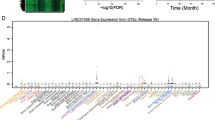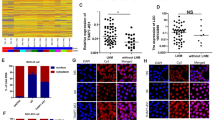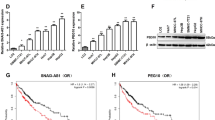Abstract
An increasing number of studies have shown that long-noncoding RNAs (lncRNAs) are involved in the post-translational modifications (PTMs) of protein in a variety of tumors. However, little is known about the exact regulation mechanism of lncRNAs in regulating PTMs in non-small-cell lung carcinoma (NSCLC) proliferation. Metastasis-associated lung adenocarcinoma transcript1 (MALAT1) and GINS complex subunit 1(GINS1) both were upregulated and promoted proliferation progression in NSCLC. In this study, the clinicopathologic significance of MALAT1 and GINS1 in NSCLC was investigated, a positive correlation in their expression was found. The silencing of MALAT1 decreased GINS1 expression and inhibited NSCLC proliferation in vitro and in vivo. The upregulation of GINS1 reversed NSCLC proliferation inhibited by MALAT1 knockdown. FOXP3 (forkhead box protein 3) was identified as the critical transcription factor for GINS1 transcription. In addition, MALAT1 could stabilize FOXP3 by binding to zinc finger (ZF) domain and leucine zipper (LZ) domain of FOXP3. Interestingly, these two domains were also interaction domains for FOXP3 binding with E3 ligase STUB1 (STIP1 homology and U-box containing protein 1). In this way, MALAT1 masked the protein-interacting domain, and inhibited FOXP3 ubiquitination by STUB1. Together, our results identified a novel regulatory axis of MALAT1-FOXP3-GINS1, and demonstrated that MALAT1 played an important modulatory role in PTM of FOXP3 which affects GINS1 transcription and drives proliferation character in NSCLC.
This is a preview of subscription content, access via your institution
Access options
Subscribe to this journal
Receive 50 print issues and online access
$259.00 per year
only $5.18 per issue
Buy this article
- Purchase on Springer Link
- Instant access to full article PDF
Prices may be subject to local taxes which are calculated during checkout







Similar content being viewed by others
References
Chen L, Liu S, Tao Y. Regulating tumor suppressor genes: post-translational modifications. Signal Transduct Target Ther. 2020;5:90 https://doi.org/10.1038/s41392-020-0196-9.
Amodio N, Raimondi L, Juli G, Stamato MA, Caracciolo D, Tagliaferri P, et al. MALAT1: a druggable long non-coding RNA for targeted anti-cancer approaches. J Hematol Oncol. 2018;11:63 https://doi.org/10.1186/s13045-018-0606-4.
Ji P, Diederichs S, Wang W, Boing S, Metzger R, Schneider PM, et al. MALAT-1, a novel noncoding RNA, and thymosin beta4 predict metastasis and survival in early-stage non-small cell lung cancer. Oncogene. 2003;22:8031–41. https://doi.org/10.1038/sj.onc.1206928.
Malakar P, Stein I, Saragovi A, Winkler R, Stern-Ginossar N, Berger M, et al. Long noncoding RNA MALAT1 regulates cancer glucose metabolism by enhancing mTOR-mediated translation of TCF7L2. Cancer Res. 2019;79:2480–93. https://doi.org/10.1158/0008-5472.CAN-18-1432.
Yu W, Ding J, He M, Chen Y, Wang R, Han Z, et al. Estrogen receptor beta promotes the vasculogenic mimicry (VM) and cell invasion via altering the lncRNA-MALAT1/miR-145-5p/NEDD9 signals in lung cancer. Oncogene. 2019;38:1225–38. https://doi.org/10.1038/s41388-018-0463-1.
Li S, Ma F, Jiang K, Shan H, Shi M, Chen B. Long non-coding RNA metastasis-associated lung adenocarcinoma transcript 1 promotes lung adenocarcinoma by directly interacting with specificity protein 1. Cancer Sci. 2018;109:1346–56. https://doi.org/10.1111/cas.13587.
Brown JA, Kinzig CG, DeGregorio SJ, Steitz JA. Methyltransferase-like protein 16 binds the 3’-terminal triple helix of MALAT1 long noncoding RNA. Proc Natl Acad Sci USA. 2016;113:14013–8. https://doi.org/10.1073/pnas.1614759113.
Liu N, Zhou KI, Parisien M, Dai Q, Diatchenko L, Pan T. N6-methyladenosine alters RNA structure to regulate binding of a low-complexity protein. Nucleic acids Res. 2017;45:6051–63. https://doi.org/10.1093/nar/gkx141.
Chen R, Liu Y, Zhuang H, Yang B, Hei K, Xiao M, et al. Quantitative proteomics reveals that long non-coding RNA MALAT1 interacts with DBC1 to regulate p53 acetylation. Nucleic acids Res. 2017;45:9947–59. https://doi.org/10.1093/nar/gkx600.
Gambus A, Jones RC, Sanchez-Diaz A, Kanemaki M, van Deursen F, Edmondson RD, et al. GINS maintains association of Cdc45 with MCM in replisome progression complexes at eukaryotic DNA replication forks. Nat cell Biol. 2006;8:358–66. https://doi.org/10.1038/ncb1382.
Ilves I, Petojevic T, Pesavento JJ, Botchan MR. Activation of the MCM2-7 helicase by association with Cdc45 and GINS proteins. Mol cell. 2010;37:247–58. https://doi.org/10.1016/j.molcel.2009.12.030.
Masai H, Matsumoto S, You Z, Yoshizawa-Sugata N, Oda M. Eukaryotic chromosome DNA replication: where, when, and how? Annu Rev Biochem. 2010;79:89–130. https://doi.org/10.1146/annurev.biochem.052308.103205.
Cottineau J, Kottemann MC, Lach FP, Kang YH, Vely F, Deenick EK, et al. Inherited GINS1 deficiency underlies growth retardation along with neutropenia and NK cell deficiency. J Clin Investig. 2017;127:1991–2006. https://doi.org/10.1172/JCI90727.
Ueno M, Itoh M, Kong L, Sugihara K, Asano M, Takakura N. PSF1 is essential for early embryogenesis in mice. Mol Cell Biol. 2005;25:10528–32. https://doi.org/10.1128/MCB.25.23.10528-10532.2005.
Srinivasan SV, Dominguez-Sola D, Wang LC, Hyrien O, Gautier J. Cdc45 is a critical effector of myc-dependent DNA replication stress. Cell Rep. 2013;3:1629–39. https://doi.org/10.1016/j.celrep.2013.04.002.
Nakahara I, Miyamoto M, Shibata T, Akashi-Tanaka S, Kinoshita T, Mogushi K, et al. Upregulation of PSF1 promotes the growth of breast cancer cells. Genes Cells: devoted Mol Cell mechanisms. 2010;15:1015–24. https://doi.org/10.1111/j.1365-2443.2010.01442.x.
Lian YF, Li SS, Huang YL, Wei H, Chen DM, Wang JL, et al. Upregulated and interrelated expressions of GINS subunits predict poor prognosis in hepatocellular carcinoma. Biosci rep. 2018;38. https://doi.org/10.1042/BSR20181178.
Tang L, Yu W, Wang Y, Li H, Shen Z. Anlotinib inhibits synovial sarcoma by targeting GINS1: a novel downstream target oncogene in progression of synovial sarcoma. Clin Transl Oncol: Off Publ Federation Span Oncol Societies Natl Cancer Inst Mex. 2019;21:1624–33. https://doi.org/10.1007/s12094-019-02090-2.
Tahara H, Naito H, Kise K, Wakabayashi T, Kamoi K, Okihara K, et al. Evaluation of PSF1 as a prognostic biomarker for prostate cancer. Prostate cancer prostatic Dis. 2015;18:56–62. https://doi.org/10.1038/pcan.2014.46.
Zhang J, Wu Q, Wang Z, Zhang Y, Zhang G, Fu J, et al. Knockdown of PSF1 expression inhibits cell proliferation in lung cancer cells in vitro. Tumour Biol: J Int Soc Oncodev Biol Med. 2015;36:2163–8. https://doi.org/10.1007/s13277-014-2826-8.
Cunha LL, Morari EC, Nonogaki S, Soares FA, Vassallo J, Ward LS. Foxp3 expression is associated with aggressiveness in differentiated thyroid carcinomas. Clinics. 2012;67:483–8. https://doi.org/10.6061/clinics/2012(05)13.
Yang S, Liu Y, Li MY, Ng CSH, Yang SL, Wang S, et al. FOXP3 promotes tumor growth and metastasis by activating Wnt/beta-catenin signaling pathway and EMT in non-small cell lung cancer. Mol cancer. 2017;16:124 https://doi.org/10.1186/s12943-017-0700-1.
Wang X, Li X, Wei X, Jiang H, Lan C, Yang S, et al. PD-L1 is a direct target of cancer-FOXP3 in pancreatic ductal adenocarcinoma (PDAC), and combined immunotherapy with antibodies against PD-L1 and CCL5 is effective in the treatment of PDAC. Signal Transduct Target Ther. 2020;5:38 https://doi.org/10.1038/s41392-020-0144-8.
Ma H, Gao W, Sun X, Wang. WSTAT5 and TET2 cooperate to regulate FOXP3-TSDR demethylation in CD4(+) T cells of patients with colorectal cancer. J Immunol Res. 2018;2018:6985031 https://doi.org/10.1155/2018/6985031.
Szylberg L, Karbownik D, Marszalek A. The role of FOXP3 in human cancers. Anticancer Res. 2016;36:3789–94.
Jia H, Qi H, Gong Z, Yang S, Ren J, Liu Y, et al. The expression of FOXP3 and its role in human cancers. Biochimica et biophysica acta Rev cancer. 2019;1871:170–8. https://doi.org/10.1016/j.bbcan.2018.12.004.
Loo CS, Gatchalian J, Liang Y, Leblanc M, Xie M, Ho J, et al. A genome-wide CRISPR screen reveals a role for the non-canonical nucleosome-remodeling BAF complex in Foxp3 expression and regulatory T cell function. Immunity. 2020;53:143–57. https://doi.org/10.1016/j.immuni.2020.06.011.
Chen Z, Barbi J, Bu S, Yang HY, Li Z, Gao Y, et al. The ubiquitin ligase Stub1 negatively modulates regulatory T cell suppressive activity by promoting degradation of the transcription factor Foxp3. Immunity. 2013;39:272–85. https://doi.org/10.1016/j.immuni.2013.08.006.
Ma X, Dang Y, Shao X, Chen X, Wu F, Li Y. Ubiquitination and long non-coding RNAs regulate actin cytoskeleton regulators in cancer progression. Int j of mol sci. 2019;20. https://doi.org/10.3390/ijms20122997.
Zhang X, Hamblin MH, Yin KJ. The long noncoding RNA Malat1: its physiological and pathophysiological functions. RNA Biol. 2017;14:1705–14. https://doi.org/10.1080/15476286.2017.1358347.
Jin D, Guo J, Wu Y, Du J, Yang L, Wang X, et al. m(6)A mRNA methylation initiated by METTL3 directly promotes YAP translation and increases YAP activity by regulating the MALAT1-miR-1914-3p-YAP axis to induce NSCLC drug resistance and metastasis. J Hematol Oncol. 2019;12:135 https://doi.org/10.1186/s13045-019-0830-6.
Li S, Wang Q, Qiang Q, Shan H, Shi M, Chen B, et al. Sp1-mediated transcriptional regulation of MALAT1 plays a critical role in tumor. J cancer Res Clin Oncol. 2015;141:1909–20. https://doi.org/10.1007/s00432-015-1951-0.
Stamato MA, Juli G, Romeo E, Ronchetti D, Arbitrio M, Caracciolo D, et al. Inhibition of EZH2 triggers the tumor suppressive miR-29b network in multiple myeloma. Oncotarget. 2017;8:106527–37. https://doi.org/10.18632/oncotarget.22507.
Wang W, Zhu Y, Li S, Chen X, Jiang G, Shen Z, et al. Long noncoding RNA MALAT1 promotes malignant development of esophageal squamous cell carcinoma by targeting beta-catenin via Ezh2. Oncotarget. 2016;7:25668–82. https://doi.org/10.18632/oncotarget.8257.
Tripathi V, Ellis JD, Shen Z, Song DY, Pan Q, Watt AT, et al. The nuclear-retained noncoding RNA MALAT1 regulates alternative splicing by modulating SR splicing factor phosphorylation. Mol cell. 2010;39:925–38. https://doi.org/10.1016/j.molcel.2010.08.011.
Zhang A, Zhao JC, Kim J, Fong KW, Yang YA, Chakravarti D, et al. LncRNA HOTAIR enhances the androgen-receptor-mediated transcriptional program and drives castration-resistant prostate cancer. Cell Rep. 2015;13:209–21. https://doi.org/10.1016/j.celrep.2015.08.069.
Jiang R, Tang J, Chen Y, Deng L, Ji J, Xie Y, et al. The long noncoding RNA lnc-EGFR stimulates T-regulatory cells differentiation thus promoting hepatocellular carcinoma immune evasion. Nat Commun. 2017;8:15129 https://doi.org/10.1038/ncomms15129.
Yu T, Zhao Y, Hu Z, Li J, Chu D, Zhang J, et al. MetaLnc9 facilitates lung cancer metastasis via a PGK1-activated AKT/mTOR pathway. Cancer Res. 2017;77:5782–94. https://doi.org/10.1158/0008-5472.CAN-17-0671.
Takayama Y, Kamimura Y, Okawa M, Muramatsu S, Sugino A, Araki H. GINS, a novel multiprotein complex required for chromosomal DNA replication in budding yeast. Genes Dev. 2003;17:1153–65. https://doi.org/10.1101/gad.1065903.
Li Z, Li D, Tsun A, Li B. FOXP3+ regulatory T cells and their functional regulation. Cell Mol Immunol. 2015;12:558–65. https://doi.org/10.1038/cmi.2015.10
Colamatteo A, Carbone F, Bruzzaniti S, Galgani M, Fusco C, Maniscalco GT, et al. Molecular mechanisms controlling Foxp3 expression in health and autoimmunity: from epigenetic to post-translational regulation. Front Immunol. 2019;10:3136 https://doi.org/10.3389/fimmu.2019.03136
Kwon HS, Lim HW, Wu J, Schnolzer M, Verdin E, Ott M. Three novel acetylation sites in the Foxp3 transcription factor regulate the suppressive activity of regulatory T cells. J Immunol. 2012;188:2712–21. https://doi.org/10.4049/jimmunol.1100903.
Song X, Li B, Xiao Y, Chen C, Wang Q, Liu Y, et al. Structural and biological features of FOXP3 dimerization relevant to regulatory T cell function. Cell Rep. 2012;1:665–75. https://doi.org/10.1016/j.celrep.2012.04.012.
Liu Y, Wang L, Predina J, Han R, Beier UH, Wang LC, et al. Inhibition of p300 impairs Foxp3(+) T regulatory cell function and promotes antitumor immunity. Nat Med. 2013;19:1173–7. https://doi.org/10.1038/nm.3286.
van Loosdregt J, Vercoulen Y, Guichelaar T, Gent YY, Beekman JM, van Beekum O, et al. Regulation of Treg functionality by acetylation-mediated Foxp3 protein stabilization. Blood. 2010;115:965–74. https://doi.org/10.1182/blood-2009-02-207118.
Li M, Zhou W, Yuan R, Chen L, Liu T, Huang D, et al. ROCK2 promotes HCC proliferation by CEBPD inhibition through phospho-GSK3beta/beta-catenin signaling. FEBS Lett. 2015;589:1018–25. https://doi.org/10.1016/j.febslet.2015.03.004.
Author information
Authors and Affiliations
Corresponding author
Ethics declarations
Conflict of interest
The authors declare no competing interests.
Additional information
Publisher’s note Springer Nature remains neutral with regard to jurisdictional claims in published maps and institutional affiliations.
Supplementary information
Rights and permissions
About this article
Cite this article
Li, M., Shi, M., Hu, C. et al. MALAT1 modulated FOXP3 ubiquitination then affected GINS1 transcription and drived NSCLC proliferation. Oncogene 40, 3870–3884 (2021). https://doi.org/10.1038/s41388-021-01816-3
Received:
Revised:
Accepted:
Published:
Issue Date:
DOI: https://doi.org/10.1038/s41388-021-01816-3
This article is cited by
-
Oncogenic roles of the lncRNA LINC00460 in human cancers
Cancer Cell International (2022)
-
Introduction of long non-coding RNAs to regulate autophagy-associated therapy resistance in cancer
Molecular Biology Reports (2022)



